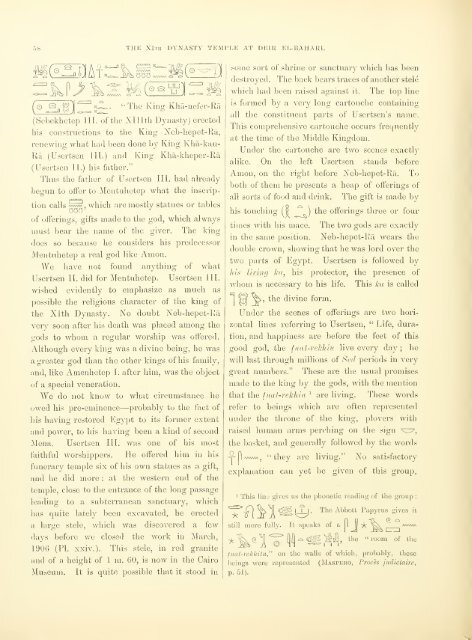The XIth dynasty temple at Deir el-Bahari .. - NYU | Digital Library ...
The XIth dynasty temple at Deir el-Bahari .. - NYU | Digital Library ...
The XIth dynasty temple at Deir el-Bahari .. - NYU | Digital Library ...
You also want an ePaper? Increase the reach of your titles
YUMPU automatically turns print PDFs into web optimized ePapers that Google loves.
68 THE XlTH DYNASTY TEMPLE AT DBIR EL-BAHARI.<br />
°i]]Af::^k^r;ii€(°HI]<br />
C oa^]<br />
o ag>^<br />
'' <strong>The</strong> Kino; Kha-iiefer-Rii<br />
(Sebekhetep 111. of the Xlllth Dynasty) erected<br />
liis constructions to the King Neb-hepet-Ra,<br />
renewing wh<strong>at</strong> had been done bv Kino; Kha-kau-<br />
Rfi (Usei'tsen 111.) and King Kha-kheper-Ra.<br />
(Usertsen II.) his f<strong>at</strong>her."<br />
Thus the f<strong>at</strong>her of Usertsen III. had already<br />
begun to otter to Mentuhetep wh<strong>at</strong> the inscrip-<br />
til tllllH<br />
tion calls ^^•^•^ , which are mostly st<strong>at</strong>ues or tables<br />
of offerings, gifts made to the god, which always<br />
must bear the name of the giver. <strong>The</strong> king<br />
does so because he considei's his predecessor<br />
Mentuhetep a real god like Amon.<br />
We have not found anything of wh<strong>at</strong><br />
Usertsen II. did for Mentuhetep. Usertsen 111.<br />
wished evidently to emphasize as much as<br />
possible the r<strong>el</strong>igious character of the king of<br />
the Xlth Dynasty. No doubt Neb-hepet-Ra<br />
very soon after his de<strong>at</strong>h was placed among the<br />
gods to whom a regular worship was offered.<br />
Although every king was a divine being, he was<br />
a gre<strong>at</strong>er god than the other kings of his family,<br />
and, like Amenhetep I. after him, was the object<br />
of a special vener<strong>at</strong>ion.<br />
We do not know to wh<strong>at</strong> circumstance he<br />
owed his pre-eminence— probably to the fact of<br />
his having restored Egypt to its former extent<br />
and power, to his having been a kind of second<br />
Mena. Usertsen III. was one of his most<br />
faithful worshippei's. He offered him in his<br />
funerary <strong>temple</strong> six of his own st<strong>at</strong>ues as a gift,<br />
aud he did more : <strong>at</strong> the western end of the<br />
<strong>temple</strong>, close to the entrance of the long passage<br />
leading to a subterranean sanctuary, which<br />
has quite l<strong>at</strong><strong>el</strong>y been excav<strong>at</strong>ed, he erected<br />
a large st<strong>el</strong>e, which was discovered a few<br />
days before we closed the work in IMarch,<br />
1906 (PI. xxiv.). This st<strong>el</strong>e, in red granite<br />
and of a height of 1 m. 60, is now in the Cairo<br />
Museum. It is quite possible th<strong>at</strong> it stood in<br />
some sort of shrine or sanctuary which has been<br />
destroyed. <strong>The</strong> back bears traces of another st<strong>el</strong>e<br />
which had been raised against it. <strong>The</strong> top line<br />
is formed by a very long cartouche containing<br />
all the constituent parts of Usertsen's name.<br />
This comprehensive cartouche occurs frequently<br />
<strong>at</strong> the time of the Middle Kingdom.<br />
Under the cartouche are two scenes exactly<br />
alike. On the left Usertsen stands before<br />
Amon, on the right before Neb-hepet-Ra. To<br />
both of them he presents a heap of offerings of<br />
all sorts of food and drink. <strong>The</strong> gift is made by<br />
his touching (fi ) the offerings three or four<br />
times with his mace. <strong>The</strong> two gods are exactly<br />
in the same i^osition. Neb-hepet-Ra wears the<br />
double crown, showing th<strong>at</strong> he was lord over the<br />
two parts of Egypt. Usertsen is followed by<br />
his livinij L'lj, his protector, the presence of<br />
whom is necessary to his life. This ka is called<br />
I M<br />
^^^ divine form.<br />
V''<br />
Under the scenes of offerings are two hori-<br />
zontal lines referring to Usertsen, " Life, dui-a-<br />
tion, and happiness are before the feet of this<br />
good god, the iu.<strong>at</strong>-r<strong>el</strong>ihm live every day ; he<br />
will last through millions of Sed periods in very<br />
gre<strong>at</strong> numbers." <strong>The</strong>se are the usual promises<br />
made to the king by the gods, with the mention<br />
th<strong>at</strong> the tu<strong>at</strong>-rekhiu ^ are living. <strong>The</strong>se Avords<br />
refer to beings which are often represented<br />
under the throne of the king, plovers with<br />
raised human arms perching on the sign ^^3^,<br />
the basket, and generally followed by the words<br />
-pn^^^vA^Aj "they are living." No s<strong>at</strong>isfactory<br />
explan<strong>at</strong>ion can yet be given of this group,<br />
1 This lim; gives us the phonetic veading of the group :<br />
^ SO W> rt "^^ !-£-'• •'-^^ Abbott Papyrus gives it<br />
still more fully. It speaks of a I<br />
^'^©'^'^(jfj-^^sQ,<br />
JMc ^^<br />
'^^'"^^<br />
the "room of the<br />
tu<strong>at</strong>-rckliitu," on the walls of which, probably, these<br />
beings were represented (Maspero, Proces judiciaire,<br />
p. 51).

















